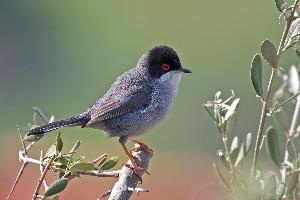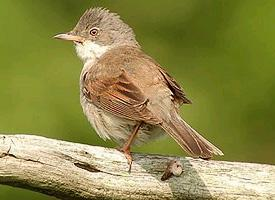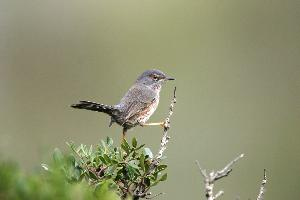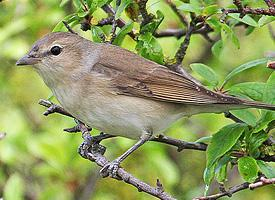
Popis zvířete
The Sardinian Warbler (Sylvia melanocephala) is a small, yet captivating bird species that belongs to the family Sylviidae, known for its diverse group of warblers. Native to the Mediterranean region, this bird is particularly widespread across the western and central parts of the basin. It has also been observed in parts of Europe and Africa, showcasing its adaptability to different environments.Characterized by its striking appearance, the Sardinian Warbler exhibits sexual dimorphism, meaning males and females have distinct plumage. Males are easily recognizable by their coal-black heads, contrasted with a white throat and a mesmerizing red ring around their eyes. Their upperparts are a grayish color, blending seamlessly into the Mediterranean landscapes, while their underparts are a lighter gray, sometimes with a pinkish tinge. On the other hand, females and juveniles display a more subdued coloration, with a pale grayish-brown head, and lack the male's vivid eye rings, making them more challenging to spot against the dense shrubbery of their habitats.
This species prefers a habitat characterized by thick underbrush, often found in maquis shrubland, garigue, and even in well-vegetated gardens and parks. Their presence is usually heralded by their distinctive song, a melodious and varied tune that includes harsher notes and mimicry of other bird species. The Sardinian Warbler is primarily insectivorous, feeding on a diet of small invertebrates, but it also consumes berries and small fruits, especially outside the breeding season.
Breeding from late March to July, the Sardinian Warbler constructs its nest close to the ground, hidden in dense shrubs or low vegetation. The female lays between 3 to 5 eggs, which she incubates for about two weeks. Both parents are involved in feeding the chicks, which fledge approximately two weeks after hatching.
Despite facing threats from habitat destruction and degradation in some areas, the Sardinian Warbler is classified as Least Concern by the International Union for Conservation of Nature (IUCN), thanks to its wide range and large, stable population. This resilient bird continues to thrive in its Mediterranean home, adding beauty and song to the region's rich biodiversity.
The Sardinian Warbler's adaptability, coupled with its distinctive appearance and song, make it a fascinating subject of study for ornithologists and a delightful sighting for bird watchers. Its presence is a testament to the rich avian life that thrives in the Mediterranean's varied landscapes, contributing to the ecological balance and biodiversity of the region.
Podobná zvířata
Nové fotografie zvířat
Top 10 zvířat
- Chinese water dragon (Physignathus cocincinus)
- Galápagos tortoise (Geochelone nigra complex)
- Dolphin gull (Leucophaeus scoresbii)
- Japanese macaque (Macaca fuscata)
- Colombian red howler (Alouatta seniculus)
- Sea urchins (Echinoidea)
- Moustached guenon (Cercopithecus cephus)
- Diana monkey (Cercopithecus diana)
- Common reed warbler (Acrocephalus scirpaceus)
- Common house mosquito (Culex pipiens)


